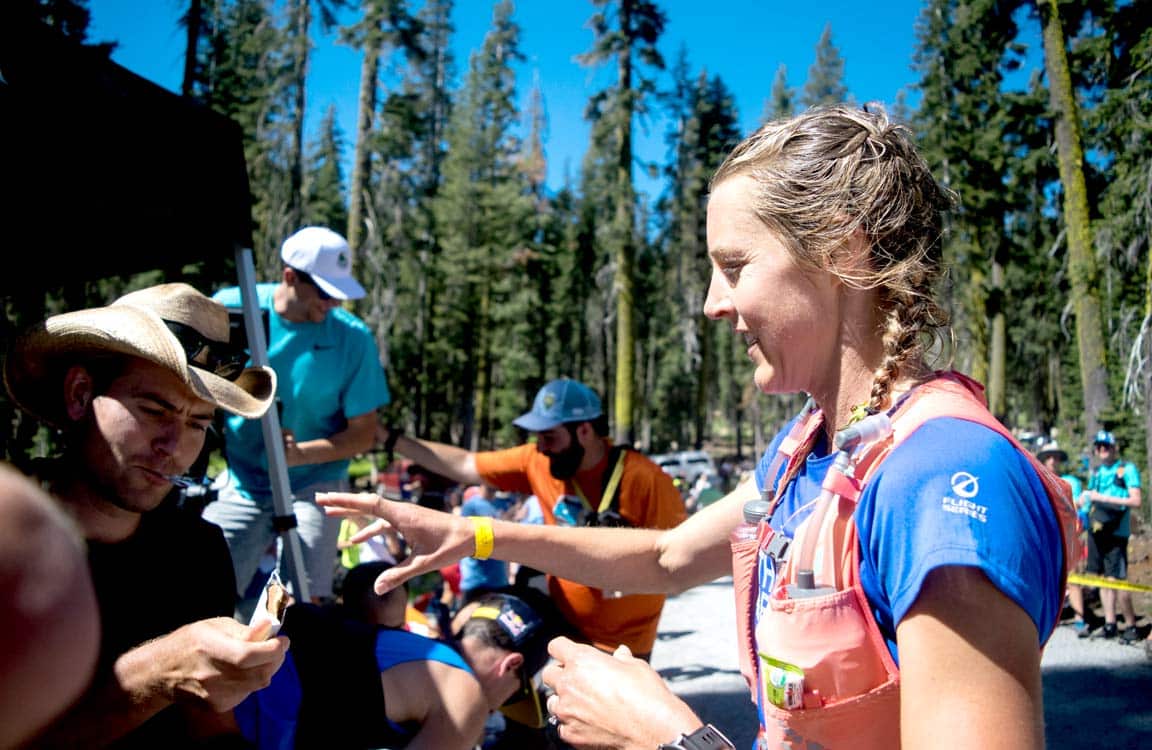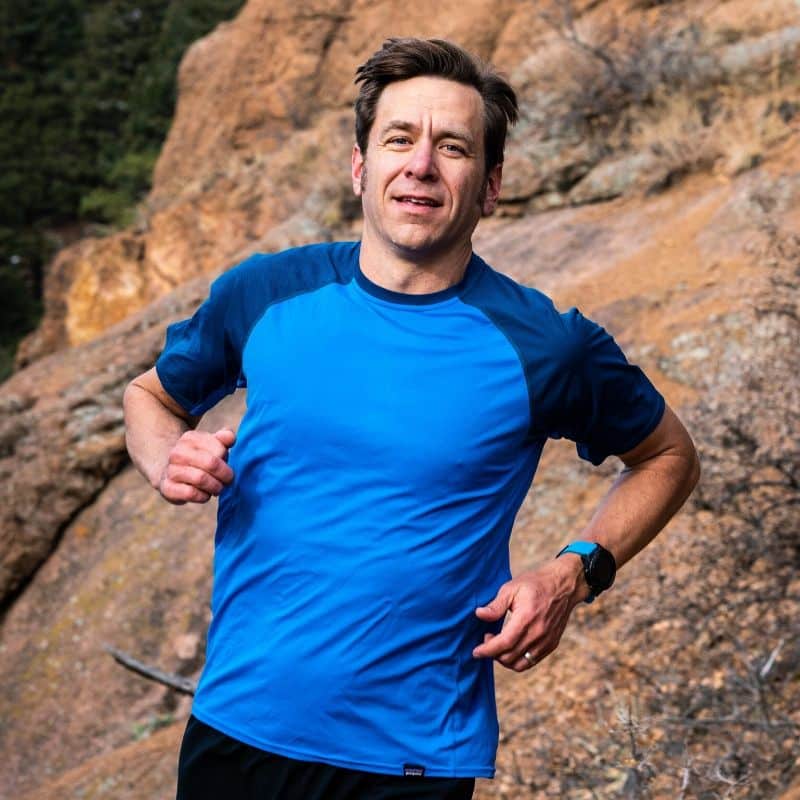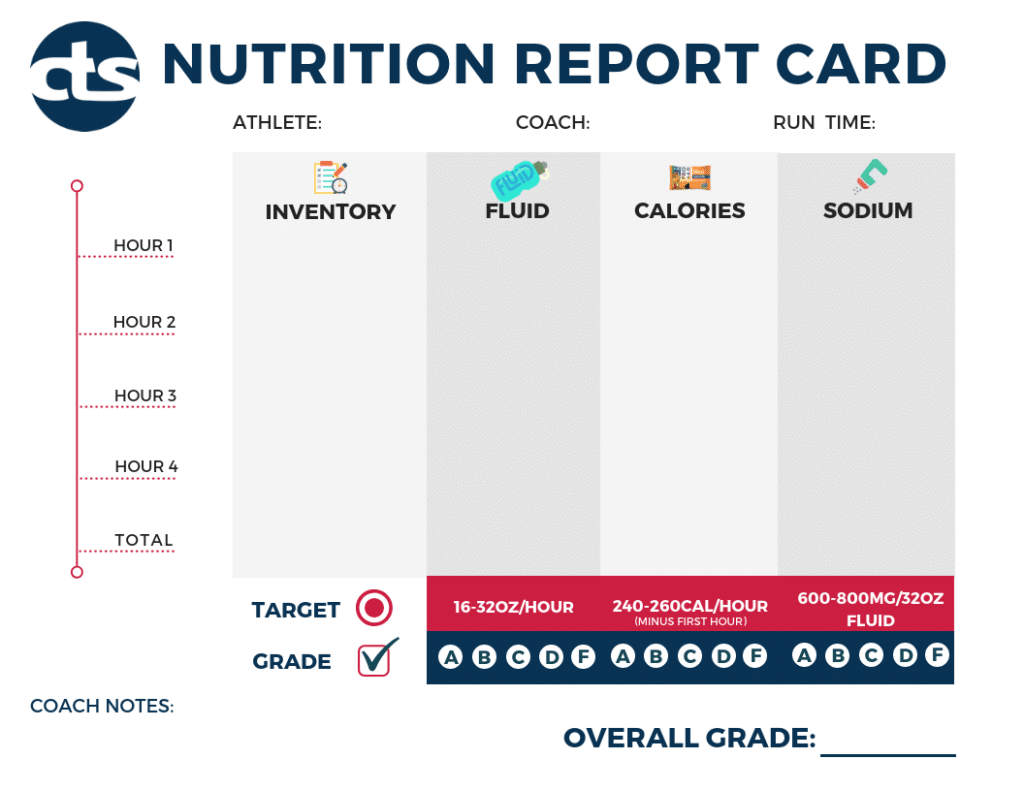
What Ultramarathon Runners Can Learn from IAAF Statement on Nutrition
By Jason Koop,
Head Coach of CTS Ultrarunning
When I first started coaching ultrarunners in the early 2000’s, one of the things that I lamented most was the lack of specific research on the sport. Other endurance sports I worked with (marathon running, cycling and triathlon) could base their best practices on decades of research. That landscape has gradually changed and we have seen, particularly in the last several years, a proliferation of emergent sports science specific to ultramarathon running.
Case in point, the international governing body for Track and Field (IAAF) recently released a position paper on ‘Nutrition for Athletes’ complete with a specific section on nutrition for ultramarathon running. While not the first paper or position statement in the sport of ultrarunning, I still do a little jump for joy any time the research gets this specific. Let’s dive in!
Race day nutrition should be based on best practices and then customized to the individual
We see phrases like ‘You are an N of 1’ and ‘this worked for me’ riddled in articles, blogs and anecdotes about ultramarathon training, particularly around nutrition. This is evident in the sheer variety of aid station snacks you will see at any ultra. The fact that people running the exact same event, at the exact same mile marker, choose to fuel up on sustenance ranging from a gel, Swedish fish, pretzels, quesadillas, soup, Snickers bars, watermelon, and sometimes a bit of all of the above, screams that we all have our own individual likes and dislikes during the course of an ultra.
In what other world would this hodgepodge of sweet, salty, crunchy, gooey, prepared, prepackaged and engineered foodstuffs all seem perfectly appropriate at any given time and all at the same time? In the author’s words, “It is clear that individual assessment to determine daily and event nutrition and hydration requirements, based on the runner’s specificities (e.g. physiology, tolerance and preference) and event characteristics, it is essential to inform appropriate customized nutrition action plans.” In other words, individualization is key, but it has to be grounded in reality.
Nutrition Report Card
I’ve written before on how to develop your Bullseye Nutrition Plan, and that’s a good start. Your next step is to practice your plan to see if it works for you (i.e. your tolerance and preference) under the conditions of the race (i.e. event characteristics, or at least as close as you can get to those conditions in training).
As you activate your plan, a simple test to see if you are on track is to record everything you eat and drink on a long run and then grade yourself. Nothing brings out focus like a good old high school letter grade to determine the worthiness of your effort. At our ultrarunning camps, we identify one of the longer runs to be a nutrition focused run. After the run is completed, we use the discarded wrappers as an inventory system to catalogue what athletes ate and drank. We then use the following report card and grade each athlete on how they did.
The target calorie and fluid ranges at the bottom are used universally for everyone to start (240-260 cal/hour, 16-32 oz of fluid per hour and 600-800 mg Na per 32 oz of fluid) and then we customize them to each athlete based on their goals and race. Quite literally, we are starting with best practices and then individualizing the plan for each athlete. The goal of the exercise is ultimately to educate each athlete on what they are actually consuming. Most of the time, athletes are surprised by their total calorie and fluid intake, as they are typically under fueled and have no clue how much fluid they have consumed. The research teases this out as ultrarunners report consuming 80-120 cal/hour 5,9,11,15 (as compared to the ~240-260 cal/hour they should be taking in) and finish ultramarathons both over and underhydrated with or without hyponatremia 7.
Lower caloric expenditures make the argument both for and against low carb-high fat protocols
I hate to burst anyone’s bubble, but compared to any of the Olympic running events (remember this is an IAAF consensus statement), ultramarathons are slow. And slower running means a slower rate of energy utilization. This fact alone makes the case both for and against utilizing a fat adaptation strategy, where an athlete will use various nutrition manipulations to burn more fat and less carbohydrate during exercise. Yes, I do get a chuckle out of it as it is the ultimate irony.
Fat adaptation proponents will argue that we have a nearly unlimited potential for energy stored in our fat.
This is true.
And, it is also true that by using various fat adaptation strategies (running while fasted, using a low carb-high fat or ketogenic diet, etc.) you can shift your fuel utilization to burn more fat at the same relative intensity. 3,8,13,17.
And finally, because the exercise intensity (and therefore caloric burn rate) during an ultramarathon is relatively low (~500-700 cal/hour), you can fuel your ultramarathon better on fats despite the fact that liberating energy from fat requires more oxygen than liberating energy from carbohydrate (i.e. burning fat is less economical).
I understand the strategy; I just don’t agree with it, for four reasons:
- Simply by training, you increase your body’s ability to burn fat. As the author puts it, “high fat oxidation rates also appear to be inherent in ultramarathon runners regardless of background macronutrient dietary modifications.”
- Adherence to a Low Carbohydrate High Fat (LCHF) or ketogenic diet is problematic for most people. And adherence is a key efficacious point of both of these diets.
- Athletes undertaking a LCHF/ketogenic diet, or attempting to fast, are more at risk of being in an energy deficiency, which can lead to overtraining syndrome, illness or injury 10,12.
- We don’t quite know how transient fat adaptation strategies are. Meaning, if you undertake any of these fat adaptation strategies, how quickly do the adaptations come and go? Will they disappear or diminish during a taper or if you take a gel at an aid station? We simply do not know the extent of this aspect.
I take the stance that because the rate of energy expenditure is low, and ultramarathon athletes already have well developed fax oxidation capabilities, they need not undertake a specific fat adaption protocol as long as they have developed their nutrition strategy in training. The carbohydrate demands for most ultrarunners in most situations are actually not all that high (50-75 g/CHO/hour) compared to the maximum carbohydrate utilization that can be seen in a laboratory setting (>90 grams CHO/hour)16. So, feel free to have a pizza, train your gut and practice your nutrition strategy, and you can skip counting the carbs.
The ‘drink to thirst’ vs. ‘drink on a schedule’ debate rages on
Quick history lesson- Over the last 20 years, the American College of Sports Medicine (ACSM) has adopted the following disparate position statements on hydration strategies for athletes-
► Free Ultrarunning Training Assessment Quiz
Take our free 2-minute quiz to discover how effective your training is and get recommendations for how you can improve.
- In 1996- ’During exercise, athletes should start drinking early and at regular intervals in an attempt to consume fluids at a rate sufficient to replace all the water lost through sweating (i.e., body weight loss), or consume the maximal amount that can be tolerated 6. (emphasis mine)
- In 2007- ‘Because there is considerable variability in sweating rates and sweat electrolyte content between individuals, customized fluid replacement programs are recommended’ 2 (emphasis mine again).
- In 2013- ‘During exercise, drink according to your thirst sensation; no more or no less’ 14.
- And finally, and contradictorily, in the same 2013 statement- ‘Fluid replacement strategies should be individualized and take into consideration environmental conditions, exercise intensity and duration, pre-post body weight, body size, and other individual characteristics’ 14.
So we have the evolution of advising athletes that goes from ‘drink as much as you can’, to ‘find a customized solution’ to ‘drink to thirst, but customize it’. Who knows what the next 5 years will bring. The IAAF consensus statement furthers the confusion by stating, “Proper hydration during ultramarathon participation can generally by maintained by drinking to thirst.” You can insert either the ‘palm-on-face’ or ‘shrug’ emoji here, both appropriately convey the confusion you probably have from trying to keep track.
With all due respect to the authors, I disagree. Ultramarathon runners should not solely ‘drink to thirst’.
Ultramarathon events are complex. Different distances and durations, altitudes, temperatures, and relative intensities will conspire and confound an ultramarathoner’s sweat rate and their perception of thirst. Furthermore, the sensation of thirst is an ambiguous sensation for many athletes to grasp. As a coach who has supported many athletes in a vast array of ultramarathon races, I can attest to utterly bizarre looks of confusion when I have asked athletes at an aid station the simple question: “Are you thirsty?” They sometimes look at me as I had sprouted a second head.
In my coaching experience, ultrarunners don’t understand the concept of ‘thirsty’ when their bodies and minds are fried from hours of physical exertion. If you want some research to back this anecdote up, many of these arguments against the ‘drink to thirst’ recommendation are discussed in this excellent counterview paper by Lawrence Armstrong, et. al 1.
For ultramarathon runners, I recommend adopting the following hydration strategy:
- Drink when you are thirsty, but don’t use this sensation as the sole reliance to initiate drinking.
- Know your sweat rate in various conditions. Aim to replace 90-95% of this. It is worth noting that we don’t know quite yet what percentage of sweat you need to replace in an ultra. We do know that it’s not 100%.
- Drink mostly an electrolyte replacement beverage with some water (ambiguity with the words some and mostly is intentional).
- Salt pills are not necessary.
To sum it up
Research will always shape and mold how athletes train, eat and drink. Positions papers like the recent IAAF statement will always inform our decisions but should not dictate them. Athletes should adopt race day nutrition plans that are both individualized and rooted in best practices. I see no reason why they should go out of their way to become fat adapted. Finally, a combination of thirst and an individualized hydration plan will meet ultrarunners fluid and electrolyte needs.
Enjoying This Article? Get More Free Running Training Tips
Get our coaches' best training advice, delivered straight to your inbox weekly.
References
Press release on the consensus statement
https://www.iaaf.org/news/press-release/iaaf-consensus-statement-nutrition-for-athlet
You can view the consortium of papers here-
https://journals.humankinetics.com/toc/ijsnem/29/2
- Armstrong, L.E., Johnson, E.C., & Bergeron, M.F. (2016). Counterview: Is drinking to thirst adequate to appropriately maintain hydration status during prolonged endurance exercise? No. Wilderness and Environmental Medicine,27(2), 195–198. PubMed ID: 27291700 doi:10.1016/j.wem.2016.03.002
- Bergeron, M., et al. (2007). Medicine & Science in Sports & Exercise. February 2007. Volume 39 – Issue 2. doi: 10.1249/mss.0b013e31802ca597
- Burke, L.M. (2015). Re-examining high-fat diets for sports performance: Did we call the “nail in the coffin” too soon? Sports Medicine,45(Suppl. 1), 33–49. doi:10.1007/s40279-015-0393-9
- Costa, R.J.S., Knechtle, B., Tarnopolsky, M., and Hoffman, M., Nutrition for Ultramarathon Running: Trail, Track, and Road. International Journal of Sport Nutrition and Exercise Metabolism 2019 29:2, 130-140
- Costa, R.J.S., Swancott, A., Gill, S., Hankey, J., Scheer, V., Murray, A., & Thake, D. (2013a). Compromised energy and nutritional intake of ultra-endurance runners during a multi-stage ultra-marathon conducted in a hot ambient environment. International Journal of Sports Science, 3(2), 51–61.
- Convertino, A., et al. (1996). ACSM Position Stand: Exercise and Fluid Replacement. Medicine & Science in Sports & Exercise. 28. i-ix. 10.1097/00005768-199610000-00045.
- Hoffman, M.D., & Stuempfle, K.J. (2014). Hydration strategies, weight change and performance in a 161 km ultramarathon. Research in Sports Medicine, 22, 213
- Impey, S.G., Hammond, K.M., Shepherd, S.O., Sharples, A.P., Stewart, C., Limb, M., Morton, J.P. (2016). Fuel for the work required: A practical approach to amalgamating train-low paradigms for endurance athletes. Physiology Reports, 4(10), e12803. doi:10.14814/phy2.12803
- Kruseman, M., Bucher, S., Bovard, M., Kayser, B., & Bovier, P.A. (2005). Nutrient intake and performance during a mountain marathon: An observational study. European Journal of Applied Physiology, 94(1–2), 151–157. doi:10.1007/s00421-004-1234-y
- Logue D., Madigan S.M., Delahunt E., Heinen M., Mc Donnell S.J., Corish C.A. Low Energy Availability in Athletes: A Review of Prevalence, Dietary Patterns, Physiological Health, and Sports Performance. Sports Med. 2018;48:73–96. doi: 10.1007/s40279-017-0790-3.
- Martinez, S., Aguilo, A., Rodas, L., Lozano, L., Moreno, C., & Tauler, P. (2018). Energy, macronutrient and water intake during a mountain ultramarathon event: The influence of distance. Journal of Sports Science, 36(3), 333–339. doi:10.1080/02640414.2017.1306092
- Mountjoy M., Sundgot-Borgen J., Burke L., Carter S., Constantini N., Lebrun C., Meyer N., Sherman R., Steffen K., Budgett R., et al. The IOC consensus statement: Beyond the Female Athlete Triad–Relative Energy Deficiency in Sport (RED-S) Br. J. Sports Med. 2014;48:491–497. doi: 10.1136/bjsports-2014-093502.
- Pinckaers, P.J., Churchward-Venne, T.A., Bailey, D., van Loon, L.J. (2017). Ketone bodies and exercise performance: The next magic bullet or merely hype? Sports Medicine, 47(3), 383–391. PubMed ID: 27430501 doi:10.1007/s40279-016-0577-y
- Roy, B. (2013). Exercise and Fluid Replacement: Brought to you by the American College of Sports Medicine. ACSM’s Health & Fitness Journal: July/August 2013. Volume 17. doi: 10.1249/FIT.0b013e318296bc4b
- Stuempfle, K.J., Hoffman, M.D., Weschler, L.B., Rogers, I.R., & Hew-Butler, T. (2011). Race diet of finishers and non-finishers in a 100 mile (161 km) mountain footrace. Journal of the American College of Nutrition, 30(6), 529–535. PubMed ID: 22331688 doi:10. 1080/07315724.2011.10719999
- Thomas, D.T., Erdman, K.A., & Burke, L.M. (2016). American College of Sports Medicine joint position statement. Nutrition and athletic performance. Medicine & Science in Sports & Exercise, 48(3), 543– 568. doi:10.1249/MSS.0000000000000852
- Volek, J.S., Freidenreich, D.J., Saenz, C., Kunces, L.J., Creighton, B.C., Bartley, J.M., . . . Phinney, S.D. (2016). Metabolic characteristics of keto-adapted ultra-endurance runners. Metabolism: Clinical and Experimental, 65(3), 100–110. doi:10.1016/j.metabol.2015. 10.028



Comments 10
Pingback: Ultramarathon Daily News | Tue, Apr 23 - Yeovil Marathon
Good article and strategy. As long as I have been reading books and articles on running the advice has been contradictory, even within the same publication from qualified experts. From my non elite perspective that’s part of the fun and fascination taking it all in and trying to work out what works for me, could be a bit frustrating for the elites. Interesting to note comments re the changing ASCM hydration strategies over the past 20 years. Noakes, Lore of Running, 4th Edition, 2001, makes a similar comment on ASCM going back to 1975. Question…the nutrition report card approach targets a level of Sodium intake, why the focus on sodium, should I also consider, e.g. Potassium and magnesium? I note your strategy advises electrolytes which would take in Pot & Mag. Thanks for the article and I look forward to continue trying to solve my puzzle!
Pingback: How to Build Your Own DIY Ultrarunning Training Camp - Jason Koop
Pingback: 3 Little Things That Go a Long Way for Ultrarunners - Jason Koop
Pingback: Nutrition On The Run – @mckennaonthemove
Pingback: New Ambassadoship – @mckennaonthemove
Pingback: Hyner Hangover – Randy's Runs
Great article – thanks so much! Caught a couple of minor typos: ‘fax oxidation’ and ‘Positions papers’.
Curious as to if you believe salt pills are not neccessary for every person. The one race I didn’t use salt pills, I ended my day at mile 51 of 100 in a med tent with an IV because I collapsed due to “electrolyte imbalance” (medics words) that caused incapacitating chest pain from a sudden drop in blood pressure and the muscles around my heart seizing. This was despite taking in a bottle an hour of my calorie drink that includes 426mg Sodium and 127mg Potassium.
I went back the next year and had no issues at all with the same drink and adding a salt pill per hour despite a much hotter year. Effort level was admittedly lower though so I’m sure that played a part.
Thanks for these great articles!
Pingback: Ultramarathon Daily News | Tue, Apr 23 | Ultrarunnerpodcast.com